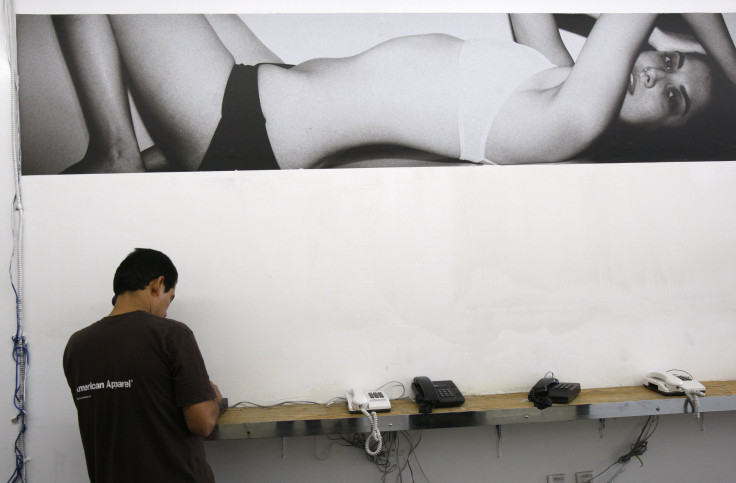American Apparel’s Porn Aesthetic: Is It Out Like Founder Dov Charney?

Dov Charney of American Apparel fame brilliantly read the zeitgeist in the new millennium and positioned the company in opposition: anti-fashion, anti-logo, anti-sweatshop, and anti-photoshop. Its ads featured young nonmodels – often unpaid American Apparel employees and sometimes porn stars like Sasha Gray and Faye Regan. Promoting "realness," the models looked like they wore no makeup, and they represented varying body types and ethnicities. American Apparel even boasted its 100 percent cotton T-shirts were “Made in Downtown LA” by happy workers paid a living wage.
But years of sexual harassment lawsuits and accusations of financial misdeeds finally caught up with him, and Charney was fired on Tuesday from American Apparel, to be replaced by Paula Schneider, a fashion-industry insider who will take over as CEO on Jan. 5, reports the Los Angeles Times. It will be interesting to see what brand strategy Schneider will take, because the American Apparel porn aesthetic seems to be, in fashion parlance, out.
“They were definitely influential in the 2000s," said beauty and fashion writer Annie Tomlin of TheGlowhow. "At the time of American Apparel's explosion, their campaigns were shocking and provocative, which fit in nicely with the weird mix of anxiety and hedonism in the post-9/11 era. Charney and photographer Terry Richardson [who's been famously responsible for the minimalist American Apparel look] successfully shocked people with their behavior — they weren't just sleazy, they were defiantly so. And for a while, it worked! But I honestly think the American Apparel/Terry Richardson aesthetic is a cliché. To young people in their 20s, that porny aesthetic feels dated and dorky and try-hard.”
Ronnie Moas of Standpoint Research market research firm told the L.A. Times that the company was a “dinosaur” and its drop in earnings could be attributed to its loss in young shoppers, who he said were going to Zara and H&M instead.
On the one hand, Charney's marketing challenged the fashion industry’s constricting ideal of beauty (heavily made up, skinny and photoshopped), but on the other hand, it replaced it with an oversexualized ideal inspired by '70s porn. Not only was American Apparel an antifashion fashion brand, it challenged '90s feminist orthodoxies in its aesthetic and through Charney’s explicitly sexist and even criminal behavior, documented at length in a New York Magazine article called A Decade of Douchery. “He rejects early-'90s feminism,” an employee told Claudine Ko in an infamous article she wrote for Jane in 2004, in which she reported that Charney masturbated in front of her eight times during the interview.
His sexist behavior seemed to be part of the American Apparel brand identity.
What Dov Charney managed to do, argues Autumn Whitefield-Madrano of The Beheld, was to copy what feminists at the time were doing – reclaiming sexist motifs, like Bust magazine’s use of “cheesecake” '50s images. That aesthetic, she said, “can be compatible with feminism, in a self-aware, ironic way.” But she says Charney used the same technique – reclaiming a '70s porn look -- and “drained it of its political potential” to create a brand.
“What's particularly clever here is that the brand didn't just look political, it was political,” Whitefield-Madrano said, “and in a way that looked friendly to women, as labor issues and women's issues have long been intertwined. The fact that it took as long as it did for the tide to truly turn against Dov Charney speaks to the success of his branding. It actually speaks to the success of branding in general, that the brand managed to appeal to a sort of 'alt' crowd, including progressive women, for as long as it did.”
For writer and fashion brand consultant Samantha Durbin, American Apparel took the sometimes porny fashion aesthetic seen in high fashion and brought it to middle America – to sell T-shirts. “He took a plain white tank and made it ‘pervy sexy,’" she said. “And there’s something to be said,” she argued, “for the real, sometimes curvy bodies you saw in American Apparel ads.” Although the porn aesthetic still exists in mainstream brands like Nasty Gal, says Durbin, Madewell and Kate Spade offer a “ladylike” look in its place.
Whatever American Apparel does in the wake of Charney’s firing, says Eli Portnoy of brand consulting firm CultureRanch, it needs to evolve.
“Dov Charney was ahead of himself years ago with American Apparel’s anti-logo logo brand. We now see luxury brands deemphasizing logos, but an innovative brand needs mature management. And it needs to evolve. Just look at Steve Jobs and Apple. American Apparel is stuck in its original concept.”
Nothing symbolizes how “stuck” in that original porn concept American Apparel was than the headline of a Huffington Post article from January: “American Apparel Pubic Hair Mannequins Stop Pedestrians In Their Tracks."
Perhaps the pornified mannequins stopped them in their tracks, but not enough to lure them inside to purchase anything.
© Copyright IBTimes 2025. All rights reserved.






















